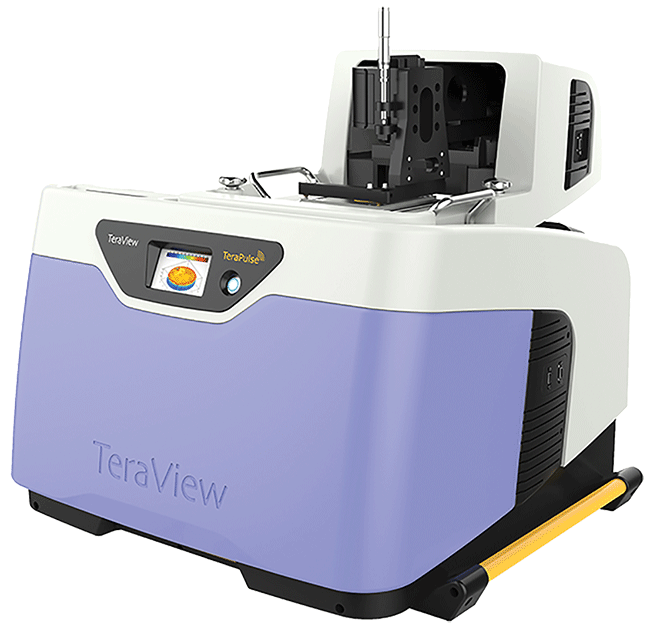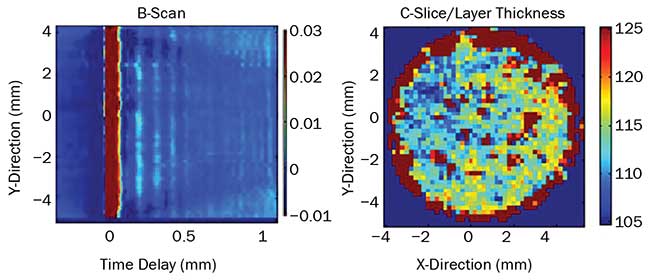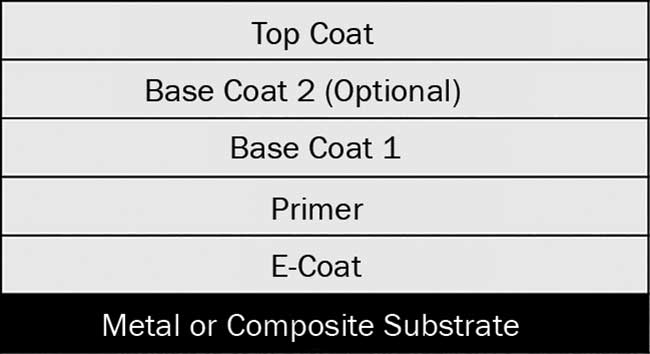Terahertz imaging is gaining interest as a method for noncontact thickness and integrity measurements of high-value coatings. Some of the greatest interest is in the pharmaceutical and automotive industries.
THOMAS R. JULIANO JR. AND PHILIP F. TADAY, TERAVIEW LTD
Terahertz imaging is a promising technique for noncontact, noninvasive, nonionizing 3D spectroscopy. Terahertz rays, located between microwave and IR on the electromagnetic spectrum from approximately 0.06 THz (60 GHz) to 10 THz, are capable of penetrating nonconducting materials and revealing information from within samples. Measurements use the time-domain profile information from a terahertz pulse to produce the 3D images.
At each surface (interface) within a sample, a terahertz pulse is partially reflected. Because terahertz pulsed imaging (TPI) is a time-of-flight technique, the difference in the time between each internal reflection with respect to the surface reflection is used to determine the depth at which each interface is located. Terahertz 3D images not only show the outside structures of samples (surface reflections), they can also explore various depths throughout samples (reflections from internal interfaces)1,2.
Several applications for terahertz imaging have been investigated in recent years. One of the largest areas of interest is high-value coatings, predominantly in the automotive and pharmaceutical industries.
Automotive companies want the ability to conduct noncontact measurements of the multilayer paint structures on automobiles. These multilayer systems often include four to five layers that need to be measured individually to assure quality. Terahertz imaging is capable of accurately making these types of measurements3,4.
In the pharmaceutical industry, such coatings on solid dosage forms are of great interest. Terahertz imaging can measure the thickness and uniformity of these coatings2,5,6.
In addition to the coating information, there are several other properties of solid dosage forms that can be evaluated using terahertz imaging. Some of the properties include irregularities within tablets (cracks, holes, etc.)7, particle size and dis tribution8, hardness, and porosity. Additionally, there is interest in using terahertz imaging to investigate artwork and historical items. The inks and paints used in the art can be investigated, as can the medium on which the art was created (canvas, wood, etc.)9-11. Some historical items, such as mummified tissue, have also been investigated12.
Terahertz imaging is capable of providing information about polymeric systems, including internal defects from manufacturing and damage caused by the exposure to force13,14.
Experimental measurements using TPI can be carried out by systems with select modules, such as TeraView’s TeraPulse 4000 (Figure 1). A benchtop terahertz spectroscopy and imaging unit, it performs several different measurement types within the single box.

Figure 1. TeraView Ltd.’s TeraPulse 4000 benchtop unit, for use in applications such as imaging and spectroscopy. Courtesy of TeraView Ltd.Courtesy of TeraView Ltd.
There are a number of plug-and-play modules available, which allow the core box to perform a number of terahertz measurements. Some of the typical modules include transmission, reflection, attenuated total reflectance (ATR), and several modules used for imaging measurements.
High-value coatings
Pharmaceuticals
TPI is a technique being used in the pharmaceutical industry to investigate a number of properties of solid-state dosage forms. Since this method is nondestructive, finished products can be examined and evaluated. One of the largest areas of interest for TPI examination of products is the coating thickness and uniformity of tablets.
A TPI system uses reflection spectroscopy principles to generate a 3D image of the sample. At each interface (change in refractive index) within the sample, some of the radiation is reflected back, leading to visible peaks in the time-domain spectra. Using the time-of-flight measurements of each reflection, the thickness of the layers can be determined.
Combining the spectral data at each point where it is acquired generates a 2D image along a line (X or Y axis) through the sample (often called a B-scan). Stacking the B-slices together generates the 3D image of the sample being examined. This image is known as a C-slice, which provides an image that can be investigated at different depths (X, Y planes) through the sample along the Z axis.

Figure 2. B-scan and C-slice of a commercial tablet. Adapted from reference 6. Courtesy of TeraView Ltd.
Figure 2 shows a B-scan and C-slice of a commercial ciprofloxacin hydrochloride monohydrate tablet6. The B-scan demonstrates the surface reflection (dark red) toward the left of the window. On the right side of the dark red line is the inside of the tablet. The C-slice shows the layer thickness map and uniformity of the coating on that side of the tablet.

Figure 3. Three bilayer tablets compressed under different conditions. Reflection from bilayer interface increases from a to c as a result of changing conditions. Adapted from reference 2. Courtesy of TeraView Ltd.
In addition to providing analysis of the coatings on pharmaceuticals, terahertz imaging can provide information about the inside of the tablets. When three bilayer tablets are each compressed at different conditions, reflectance from the bilayer interface changes (Figure 3). As the pressure used to compress the bilayers increases, so does the reflection from the bilayer interface. This type of measurement can provide information related to the porosity and hardness of the sample.
Automotive
The use of TPI in the automotive industry operates on the principle that between each layer of paint in the multilayered system there is a change in refractive index that can be detected. In this application, there are generally several layers of interest, often four or five. The application uses time-of-flight measurements to determine the thickness of several layers of coatings and paint.
In most situations, the layered system consists of an e-coat, a primer, a base layer (sometimes two), and a top coat, all on a substrate that is usually metal, but it can be composite (Figure 4). The interfaces of each of these layers provide a change in the refractive index, which causes the terahertz radiation to reflect back to the sensor at different times. The time-of-flight is assessed and allows for the accurate measurement of the individual layer thicknesses.

Figure 4. Multilayer structure of automotive coating systems. Adapted from reference 4. Courtesy of TeraView Ltd.
Terahertz imaging is gaining interest as a useful tool in the investigation of a number of areas, from the pharmaceutical and automotive industries to historical paintings and artifacts. The properties of this technique make it an ideal tool for these applications. Since terahertz radiation is nonionizing, noncontact, and able to penetrate nonconducting materials, the interest in using it for high-value coating analysis makes it a great fit, particularly for the pharmaceutical and automotive industries.
Meet the authors
Thomas R. Juliano Jr. is an applications scientist and member of the applications group at TeraView Ltd.; email: [email protected].
Philip F. Taday is the principal scientist and head of applications at TeraView Ltd.; email: [email protected].
References
1. S.S. Dhillon et al. (2017). The 2017 terahertz science and technology roadmap. J Phys D: Appl Phys, Vol. 50, article no. 043001.
2. J.A. Zeitler (2016). Pharmaceutical terahertz spectroscopy and imaging. In Analytical Techniques in the Pharmaceutical Sciences: Advances in Delivery Science and Technology, eds. A. Müllertz et al., pp. 171-222. New York: Springer. doi.org/10.1007/978-1-4030-4029-5_5.
3. S. Krimi et al. (2016). Highly accurate thickness measurement of multi-layered automotive paints using terahertz technology. Appl Phys Lett, Vol. 109, Issue 2. doi.org/10.1063/1.4955407.
4. K. Su et al. (2014). Terahertz sensor for non-contact thickness and quality measurement of automobile paints of varying complexity. IEEE Trans Terahertz Sci Technol, Vol. 4, Issue 4, pp. 432-439. doi.10.1109/TTHZ.2014.2325393.
5. M. Niwa et al. (2014). Evaluation of coating properties of enteric-coated tablets using terahertz pulsed imaging. Pharm Res, Vol. 31, Issue 8, pp. 2140-2151. doi:10.1007/s11095-014-1314-6.
6. T. Sakamoto et al. (2012). Coating and density distribution analysis of commercial ciprofloxacin hydrochloride monohydrate tablets by terahertz pulsed spectroscopy and imaging. J Pharm Innov, Vol. 7, Issue 2, pp. 87-93.
7. M. Niwa et al. (2013). Quantitative analysis of the layer separation risk in bilayer tablets using terahertz pulsed imaging. Int J Pharm, Vol. 452, Issues 1-2, pp. 249-256.
8. A. Novikova et al. (2017). A non-destructive method for quality control of the pellet distribution within a MUPS tablet by terahertz pulsed imaging. Euro J Pharm Sci, Vol. 111, pp. 549-555. doi:10.1016/j.ejps.2017.10.029.
9. K. Fukunaga and M. Picollo (2010). Terahertz spectroscopy applied to the analysis of artists’ materials. Appl Phys A, Vol. 100, Issue 3, pp. 591-597.
10. T. Bardon et al. (2017). Contrast in Terahertz images of archival documents–part I: influence of the optical parameters from the ink and support. J Infrared Milli Terahz Waves, Vol. 38, Issue 4, pp. 443-466.
11. A.S. Skryl et al. (2014). Terahertz time-domain imaging of hidden defects in wooden artworks: application to a Russian icon painting. Appl Opt, Vol. 53, Issue 6, pp. 1033-1038.
12. L. Öhrström et al. (2010). Technical note: terahertz imaging of ancient mummies and bone. Am J Phys Anthropol, Vol. 142, Issue 3, pp. 497-500.
13. J. Dong et al. (2016). Polarization-resolved terahertz imaging of intra- and inter-laminar damages in hybrid fiber-reinforced composite laminate subject to low-velocity impact. Composites, Part B: Engineering, Vol. 92, pp. 167-174.
14. N. Palka and D. Miedzinska (2014). Detailed non-destructive evaluation of UHMWPE composites in the terahertz range. Opt Quant Electron, Vol. 46, Issue 4, pp. 515-525.